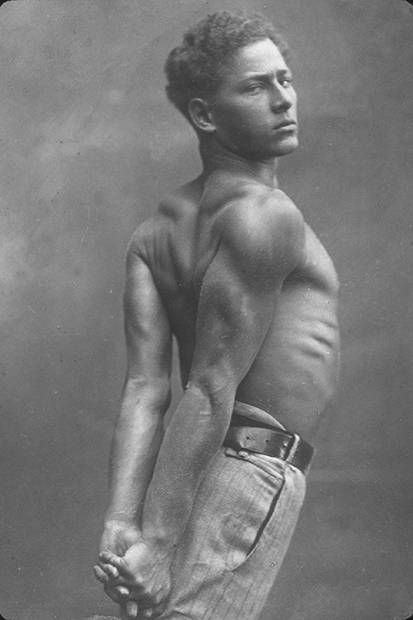On YouTube there’s a brief dance video of a Viennese waltz so enchanting that not even Fred and Ginger in ‘Cheek to Cheek’ can outcharm it. A dandy in top hat and a captivatingly pretty girl in bonnet and white frills do ecstatic jumps and twirls in each other’s arms to the seething Rosenkavalier waltz. That it’s Soviet is almost unbelievable — still more so that it dates from the still Stalinist 1954. But this is a gem by Leonid Yakobson, a choreographer who was one of the USSR’s most arresting modern voices, yet of whom you will find rare mention in the West or Soviet ballet histories.
His challenging originality was championed by the independent-minded megastars of Soviet ballet, Mikhail Baryshnikov, Natalia Makarova, Maya Plisetskaya and Rudolf Nureyev (who adopted Yakobson’s use of female feet for his own singular foot technique). In Janice Ross’s eyecatching phrase, he ‘carried modern ballet to safety’ in the USSR, despite being penalised as a Jew and a modernist.
More provocatively, she contends that he was as great a talent as George Balanchine who went West via Diaghilev’s Ballets Russes — but that he was unluckier, and braver. Both men were born in January 1904, so you can see why a twin study catches the publisher’s eye, but you should never believe what a blurb says. This isn’t a twin study. Not the right twin study, anyway.
Yakobson learned about dance in the roaring Twenties in Leningrad’s experimental cauldron, an admirer of Mayakovsky and young Shostakovich, while Balanchine was in Europe with Diaghilev. He burst into view in 1929 choreographing the ‘football’ act in The Golden Age, for which Shostakovich wrote the satirical music. He fused Jewish character grotesquery, Michel Fokine’s ballet neo-classicism and Isadora Duncan’s barefooted revolutions into a vibrant modern Soviet idiom, yet as you see from the Viennese waltz film, it could be as sexy and sweet as you like.
This fascinating character left little permanent trace on the official Soviet story, so a book is welcome. But it’s a frustrating and sometimes suspect read, written by an academic with theories to peddle, selective in evidence, and without much talent for critical narrative. Ross has spent 25 years sniffing around the subject, and it shows in the accumulation of essays that largely make up the volume — chronology jumps all over the place without narrative or argumentative coherence, and her narrow focus and absence of wider context do her theories no favours.
But if you sift with a dropping eye, you find much arresting new stuff here: exhaustive (if laboured) description of Yakobson’s widow’s archive of films, and sharp detailing of the soul-destroying political micromanagement of ballet creations — The Golden Age and Shurale, for example. There’s a much too brief telling of Yakobson’s astonishing rescue as a child from the Soviet civil war by American aid workers, a scoop that is skated over in 15 pages. Unsurprisingly late in the book we get a dancer’s view on the man himself as dictatorial, harsh, uncaring.
It’s a classic case of verdict first, evidence after. Ross selects and simplifies like billy-o to promote Yakobson as victim and unheralded genius. There is a much more ambiguous traction in the development of Soviet anti-Jewishness over time, and the Balanchine comparison is not seriously addressed. She fingers Balanchine for cynical commercialism by what as a reporter I’d consider rather dubious mis-hearsay. The mistakes about the culture minister Ekaterina Furtseva are derived, Ross notes, from Wikipedia and ‘other Russian sites’. Good god.
And it’s downright silly to deduce that the failure of American critics to fall into raptures over Yakobson’s Spartacus in 1962 was all down to Cold War prejudice. I’m afraid I too failed to be enchanted by my one glimpse of Yakobson’s work on the Kirov’s 2006 tour. But YouTube provides evidence that he was more a master of interesting miniatures than epics, at which his Moscow rival, the impressive young Yuri Grigorovich, proved more adept. Grigorovich — who ran the Bolshoi for 30 years, producing blandly forceful ballets which overshadowed Yakobson’s Leningrad experiments — is the elephant in the room. Yet Ross mentions him just five times in 500 pages. That’s the twin study that begged to be written.
Besides, Yakobson was employed virtually continually as a top-flight choreographer right up to his death at 71. He created 178 ballets, and under iron man Brezhnev he launched his own acclaimed company, Choreographic Miniatures. So what do we have here? Success story or victim? Of course it’s not as simple as either.
Available from the Spectator Bookshop, £25 Tel: 08430 600033







Comments